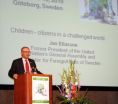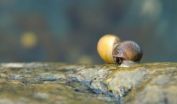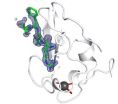Bone-anchored leg prostheses improve quality of life
2010-09-13
(Press-News.org) Today sees the presentation of a study that, for the first time, shows the results of treatment using prostheses attached to titanium implants in the bones of patients with above-the-knee amputations. It reveals that the treatment improves function and quality of life in nine out of ten patients, and is the result of research carried out at the Sahlgrenska Academy and Sahlgrenska University Hospital that is being presented this week at the International Society of Orthopaedic Surgery and Traumatology (SICOT) annual international conference in Gothenburg.
At a symposium today researcher Rickard Brånemark and others will be presenting some aspects of their OPRA study (Osseointegrated Prostheses for the Rehabilitation of Amputees) that began in 1999.
In the study, researchers at the Centre of Orthopaedic Osseointegration (COO) and the orthopaedic clinic at Sahlgrenska University Hospital in Mölndal treated 51 patients who had been amputated above the knee, with a two-year follow-up period. The patients were aged between 20 and 65, with 55% being male.
"The treatment improves both function and quality of life in more than nine out of ten patients," says Brånemark, a researcher at the Sahlgrenska Academy and orthopaedic surgeon at Sahlgrenska University Hospital. "It's important to point out that this treatment is intended for younger amputees and is not suitable for patients who have had amputations as a result of vascular disease."
More than 2,000 leg amputations are carried out each year in Sweden. While most are on elderly patients with diabetes or impaired blood circulation, some are on younger patients. Normally a leg prosthesis is attached to the amputated stump using a socket. The new technique means that the prosthesis can easily be screwed tight to a titanium implant that is anchored to the bone and protrudes from the stump.
"Attaching prostheses directly to the bone with an implant has long been an unattainable vision, and this has been in development for more than 20 years. But we are now seeing the international breakthrough for this revolutionary treatment," says Brånemark, one of the authors behind the study, who explains that work is now underway on treating other amputations such as fingers and arms.
The studies have been carried as a collaboration between Sahlgrenska University Hospital, the Department of Orthopaedics and Department of Biomaterials at the Sahlgrenska Academy, and the BIOMATCELL VINN Excellence Center of Biomaterials and Cell Therapy at the University of Gothenburg.
INFORMATION:
OSSEOINTEGRATION
Osseointegration is a way of attaching prostheses directly to the bone, and was developed in the 1960s by professor Per-Ingvar Brånemark. He discovered that titanium is not rejected by the body, but instead fuses with the surrounding bone tissue. It was originally used to replace lost teeth using titanium dental implants, a treatment method that has spread worldwide and improved the quality of life of millions of people. It has since been developed and osseointegration now has many applications, including leg, arm and face prostheses, and is also used to attach hearing aids.
For more information, please contact:
Title of the study: OPRA, Osseointegrated Prostheses for the Rehabilitation of Amputees
Authors: Rickard Brånemark, Örjan Berlin, Björn Gunterberg, Peter Bergh, Mikael Dalén, Sigvard Eriksson, Sven Inerot, Kerstin Hagberg, Gith Jansson, Eva Häggström, Hanna Berander, Eva-Louice Borg-Pearce, Charles Bragdon, Henrik Malchau, Johan Kärrholm, Björn Rydevik.
Time: OSOS Symposium, Thursday, 2 September, 13:30-15:00 and 16:00-17:45, and Friday, 3 September, 08:00-09:30 and 10:45-12:45
Download the conference programme and additional information from: www.sicot.org and/or www.ortopediveckan.se
ELSE PRESS RELEASES FROM THIS DATE:
2010-09-13
Early childhood education can play a key role in relation to change when the world fails to adopt a sustainable approach economically, ecologically and socially.
This was highlighted at the World Congress "Children, citizens in a challenged world", which was hosted by the University of Gothenburg.
In a statement, the congress urges governments around the world to protect children's right to a childhood.
More and more people are realising that work with young children is a force for change in itself, towards creating a different society. Early childhood education has ...
2010-09-13
Sexual conflict is not only a human phenomenon. Scientists at the University of Gothenburg have shown that females of the rough periwinkle conceal their gender identity in order to avoid excessive copulation.
The females of most species of snail excrete a substance in their mucous trails that enables males to find them more easily, since they can distinguish between trails from females and those from other males. The males follow the mucous trails laid down by females in order to find a partner for mating. However, the females of one of the species studied (Littorina ...
2010-09-13
VIDEO:
This video shows UBR-box recognition of an arginine residue at the beginning of a protein (blue) targeted for degradation. The structural integrity of the UBR box depends on zinc (grey)...
Click here for more information.
Our bodies recycle proteins, the fundamental building blocks that enable cell growth and development. Proteins are made up of a chain of amino acids, and scientists have known since the 1980s that first one in the chain determines the lifetime ...
2010-09-13
The new Premier League season has begun and in Madrid the World Cup celebrations are barely over, yet according to research in WIREs Cognitive Science the world's best players may soon be facing a new challenge from football playing robots, which their creators claim will be able to play and beat a human team. The research reveals how building robots to play football is driving the development of artificial intelligence and robotic technology which can be used for roles including search and rescue and home help.
The author, Claude Sammut, from the ARC Centre of Excellence ...
2010-09-13
New findings from a major drug trial have brought experts a step closer to developing a drug which could prevent thousands of British deaths from heart attacks.
Dr Robert Storey, Reader at the University of Sheffield and Consultant Cardiologist at Sheffield Teaching Hospitals, was the UK lead for international trials of a new drug, ticagrelor, which have been taking place over the last six years.
The new findings from one of these studies, the ONSET/OFFSET study, revealed that the platelet function in patients taking ticagrelor recovered much quicker after the drug ...
2010-09-13
Stroke patients who were left partially paralysed found that their condition improved after they received a simple and non-invasive method of brain stimulation, according to research in the September issue of the European Journal of Neurology.
Researchers from the Ain Shams University in Cairo, Egypt, studied 60 patients with ischaemic stroke - where the blood supply is reduced to the brain - who had been left with mild to moderate muscle weakness down one side of their body.
Twenty of the randomly assigned treatment group received repetitive transcranial magnetic ...
2010-09-13
CAMBRIDGE, Mass. - Using carbon nanotubes (hollow tubes of carbon atoms), MIT chemical engineers have found a way to concentrate solar energy 100 times more than a regular photovoltaic cell. Such nanotubes could form antennas that capture and focus light energy, potentially allowing much smaller and more powerful solar arrays.
"Instead of having your whole roof be a photovoltaic cell, you could have little spots that were tiny photovoltaic cells, with antennas that would drive photons into them," says Michael Strano, the Charles and Hilda Roddey Associate Professor of ...
2010-09-13
Berkeley – Engineers at the University of California, Berkeley, have developed a pressure-sensitive electronic material from semiconductor nanowires that could one day give new meaning to the term "thin-skinned."
"The idea is to have a material that functions like the human skin, which means incorporating the ability to feel and touch objects," said Ali Javey, associate professor of electrical engineering and computer sciences and head of the UC Berkeley research team developing the artificial skin.
The artificial skin, dubbed "e-skin" by the UC Berkeley researchers, ...
2010-09-13
Although overall mortality from cancer is decreasing in the European Union, its incidence increased by almost 20%, from 2.1 million new cases in 2002 to 2.5 million in 2008, says a special issue [1] of the European Journal of Cancer (the official journal of ECCO – the European CanCer Organisation) on cancer prevention, published today (Monday 13 September).
The current economic crisis threatens to affect cancer incidence in a number of areas, says a paper by Dr. José M. Martin-Moreno from the University of Valencia, Spain, and colleagues. Public donations to cancer ...
2010-09-13
LA JOLLA, CA – September 9, 2010 – Scientists from The Scripps Research Institute have solved a long-standing mystery of how cells conduct "quality control" to eliminate the toxic effects of a certain kind of error in protein production. The findings may lead to a better understanding of a host of neurodegenerative diseases.
The research was published in an advance, online issue of the journal Nature on September 12, 2010.
"It is exciting because we are dealing not only with a process that is clearly relevant for physiology and disease," said Scripps Research Assistant ...
LAST 30 PRESS RELEASES:
[Press-News.org] Bone-anchored leg prostheses improve quality of life




